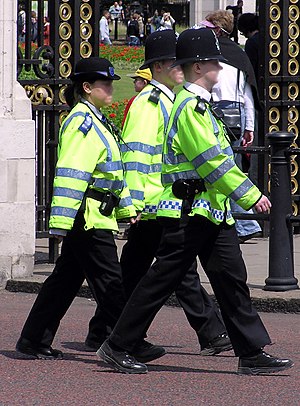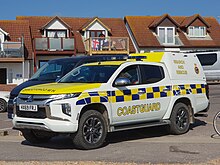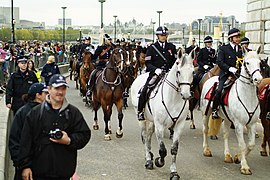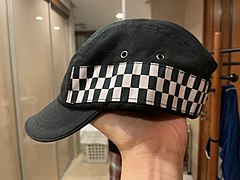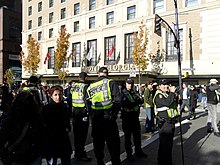
The Glengarry bonnet is a traditional Scots cap made of thick-milled woollen material, decorated with a toorie on top, frequently a rosette cockade on the left side, and ribbons hanging behind. It is normally worn as part of Scottish military or civilian Highland dress, either formal or informal, as an alternative to the Balmoral bonnet or Tam o' Shanter.
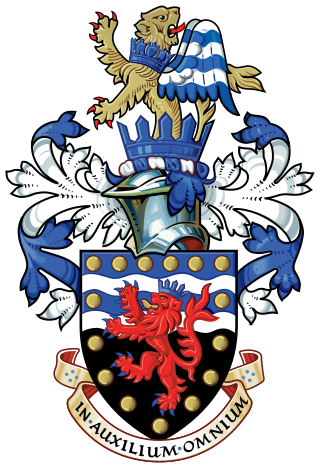
Devon and Cornwall Police is the territorial police force responsible for policing the ceremonial counties of Devon and Cornwall in South West England. The force serves approximately 1.8 million people over an area of 3,967 square miles (10,270 km2).

The City of Glasgow Police or Glasgow City Police was the police covering the city and royal burgh of Glasgow, from 1800 to 1893, and the county of city of Glasgow, from 1893 to 1975. In the 17th century, Scottish cities used to hire watchmen to guard the streets at night, augmenting a force of unpaid citizen constables. On 30 June 1800 the authorities of Glasgow successfully petitioned the British Government to pass the Glasgow Police Act establishing the City of Glasgow Police. It served Glasgow from 1800 to 1975, when it was amalgamated into Strathclyde Police.

A peaked cap, peaked hat, service cap, barracks cover, or combination cap is a form of headgear worn by the armed forces of many nations, as well as many uniformed civilian organisations such as law enforcement agencies and fire departments. It derives its name from its short visor, or peak, which was historically made of polished leather but increasingly is made of a cheaper synthetic substitute.
A military police vehicle is a vehicle used by the military police entities of a country's armed forces.

The Belfast Harbour Police is a small, specialised ports police force, with responsibility for the Port of Belfast, Northern Ireland. It was founded in 1847, making it the oldest continuously-operating law enforcement agency on the island of Ireland.

Strathclyde Police was the territorial police force responsible for the Scottish council areas of Argyll and Bute, Glasgow City, East Ayrshire, East Dunbartonshire, East Renfrewshire, Inverclyde, North Ayrshire, North Lanarkshire, Renfrewshire, South Ayrshire, South Lanarkshire and West Dunbartonshire between 1975 and 2013. The Police Authority contained members from each of these authorities.

The Hampshire and Isle of Wight Constabulary is the territorial police force responsible for policing the counties of Hampshire and the Isle of Wight in South East England.
The Royal Borough of Kensington and Chelsea Parks Police is a body of constables responsible for policing the parks and open spaces of the London Borough of Kensington and Chelsea. In 2013, it was merged with the Hammersmith and Fulham Parks Constabulary to form the Parks Police Service. Then, in July 2019 The Royal Borough of Kensington and Chelsea Parks Police moved away from The London Borough of Hammersmith and Fulham Parks Constabulary, once again becoming a single service.

York Minster Police is a small, specialised cathedral constabulary responsible for security in York Minster and its precincts in York, United Kingdom.

The custodian helmet is a type of helmet worn predominantly by male police officers in the United Kingdom, within England and Wales, and certain other places around the world. First used by the Metropolitan Police in London in 1863, the BBC labelled the custodian helmet a "symbol of British law enforcement". They are worn by male constables and sergeants on foot patrol. A cultural icon, it has featured in films, TV series and other media involving British police.
Police uniforms and equipment in the United Kingdom vary enormously per force or service, and different uniforms and equipment is used for different situations. Both what is worn and what is carried have varied considerably from the inception of the earliest recognisable mainstream police services in the early 19th century. As various laws in the mid-19th century standardised policing in the United Kingdom, so too were uniforms and equipment. From a variety of home grown uniforms, bicycles, swords and pistols the British police force evolved in look and equipment through the long coats and top hat, to the recognisable modern uniform of a white shirt, black tie, reflective jackets, body armour, and the battenburg-marked vehicles, to the present-day Airwave Solutions radios, electric vehicles and tasers.
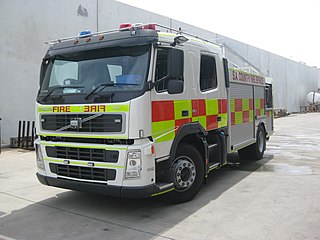
Battenburg markings or Battenberg markings are a pattern of high-visibility markings developed in the United Kingdom in the 1990s and currently seen on many types of emergency service vehicles in the UK, Crown dependencies, British Overseas Territories and several other European countries such as the Czech Republic, Iceland, Sweden, Germany, Romania, Spain, Ireland, and Belgium as well as in Commonwealth nations such as Australia, New Zealand, Hong Kong, Pakistan, Trinidad and Tobago, and more recently, Canada. The name comes from its similarity in appearance to the cross-section of a Battenberg cake.

Check is a pattern of modified stripes consisting of crossed horizontal and vertical lines which form squares. The pattern typically contains two colours where a single checker is surrounded on all four sides by a checker of a different colour.

A cathedral constable is a constable employed by a cathedral of the Church of England. They have been appointed under common law and cathedral statutes for nearly 800 years.

Liverpool Cathedral Constables are a cathedral constabulary responsible for providing security for Liverpool Cathedral.
Liverpool Markets Police was a police force maintained by Liverpool City Council to police the markets owned by the city.

The Canterbury Cathedral Close Constables are a cathedral constabulary employed by Canterbury Cathedral to maintain order and security in and around the cathedral. They have the same police powers as regular police in the United Kingdom, including the power of arrest, within the cathedral and its precincts.
The Havering Parks Constabulary is a body of constables responsible for policing the parks and open spaces of the London Borough of Havering.

The Hampstead Heath Constabulary (HHC) is the organisation that patrols Hampstead Heath, London, which is administered by the City of London Corporation.













